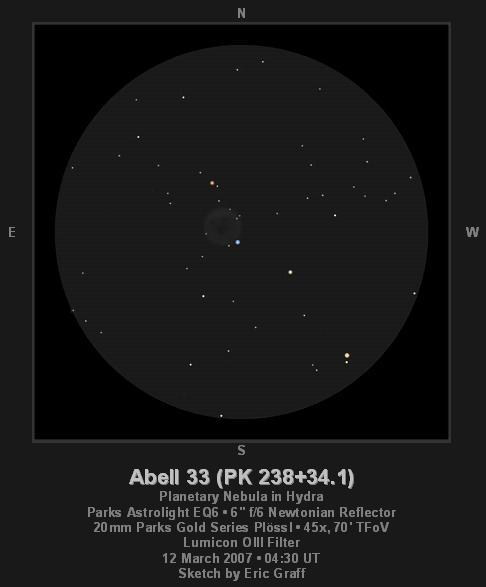Ghost of a dying star
In the western reaches of elongated Hydra, near the western border of Sextans you will find a ragged string of four stars ranging in magnitude from 6 to 8 aligned northeast to southwest located 1.7° south of 4th magnitude Iota Hydrae and 2.5° east of 5th magnitude Tau1 Hydrae (a fine, widely spaced double star). The third star from the west (and slightly out of line with the other three stars) is 7th magnitude HD 83535. This bluish-white star is superimposed on the edge of a ghostly planetary nebula known as Abell 33. My best view of this limpid pool of nebulosity was achieved with a 20mm Plössl (yielding a magnification of 45x) and an OIII filter. This setup revealed a small faint disk of tenuous nebulosity about 4½’ in diameter in contact with the 7th magnitude star on its southwest edge. The edges of the disk were reasonably sharp and the brightness faded gradually toward the darkened center. At other magnifications (both with and without the filter) the view was less distinct and the nebula became almost impossible to detect at magnifications above 60x. The 16th magnitude central star was not visible, but a trio of 13th magnitude stars (two of them a close pair) are perched on the northwestern edge of the nebula.
Abell 33 was discovered on Palomar Observatory Sky Survey plates by George O. Abell and published in the April 1966 Astrophysical Journal (Abell 1966). These nebulae, being very faint and of relatively large angular size are classified as ‘old’ or ‘evolved’ planetary nebulae. Observing the 86 objects in Abell’s catalogue constitutes one of the supreme observing challenges for amateur astronomers with large-aperture scopes; fortunately a few of them, including this one, are accessible in fairly modest equipment provided the observer has access to very dark skies and an OIII filter. Recent estimates place Abell 33 at a distance of about 1,100 light years from Earth (Phillips 2005), which implies an actual diameter of about 1.4 light years.
Subject: Abell 33 (PK 238+34.1)
Object Type: Planetary Nebula
Constellation: Hydra
Right Ascension (2000.0): 09h 39m 09.1s
Declination (2000.0): -02° 48′ 31″
Magnitude: 12.4n/15.7s
Diameter: 268″
Classification: 2b
Observer: Eric Graff
Location: Cuyamaca Mts., San Diego Co., California (4,000 ft. elevation)
Date & Time: 12 March 2007 at 04:30UT
Transparency: NELM 6.7, TLM ~14.1
Seeing: Pickering 5-6/10
Telescope: Parks Astrolight EQ6 (6″ f/6 Newtonian Reflector)
Eyepiece: 20mm Parks Gold Series Plössl (45x, 70′ TFoV)
Filter: Lumicon OIII Filter
Sketching Materials: #2 pencil, black ink, blending stump, 24# copy paper
References:
Abell, George O. 1966. Properties of Some Old Planetary Nebulae. Astrophysical Journal. 144:259-279.
Philips, J.P. 2005. The distances of highly evolved planetary nebulae. Monthly Notices of the Royal Astronomical Society. 357:2:619-625.


Eric,
On my monitor this sketch image is awesome. Hope to see many more of your great sketches here soon.
Frank